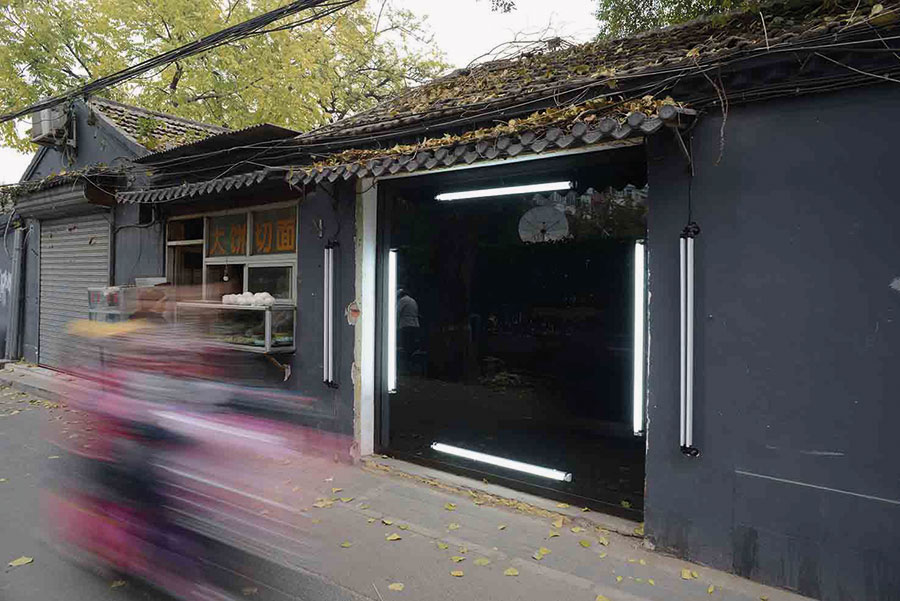How Arrow Factory Changed the Beijing Art Scene
Shuttered in the city’s crackdown on independent initiatives, the artist-run space provided a model for low-budget, experimental art making
Shuttered in the city’s crackdown on independent initiatives, the artist-run space provided a model for low-budget, experimental art making

The lone trace of what was once the Beijing project space Arrow Factory is a section of wall that has been freshly painted dark grey. Conspicuously at odds with the surrounding white walls, it is clearly a recent alteration. Until the end of October 2019, this wall was part of a storefront-turned-art-space that had been active since March 2008. Before that, it had been a neighbourhood vegetable shop and, earlier still, the bedroom of a family of three within a shared courtyard house.
Five months before the Olympic Games were held in Beijing in 2008, this 15m2 hole in the wall at 38 Jianchang Hutong was rented by four long-term residents of the neighbourhood: Chinese American artist Rania Ho and her husband, Chinese artist Wang Wei, together with Chinese artist Weng Wei and Chinese American curator Pauline J. Yao. As a group, they founded Arrow Factory – an independent art space named after the English translation of the alley’s Chinese name. They didn’t have a long-term plan but, rather, a modest intention: a space of their own for experimentation, unperturbed by the demands of the commercial art system.
The group had witnessed first hand the changing dynamics of art production in the city through the mid-2000s. In their own practices, Ho and Wang often create installations and situations that respond to specific localities and contexts. In 2003, when Beijing began to undertake large-scale urban construction after winning the bid to host the Olympic Games, Wang hired ten migrant workers to build Temporary Space: a four-metre-high brick room inside Long March Space. A narrow passageway was left between the four windowless walls and the exhibition hall. Once the structure had been completed, the workers were instructed to dismantle the four walls and recycle the bricks.

Ho and Wang were part of the Beijing-based artist initiative Complete Art Experience Project, which organized exhibitions in experimental formats and sites across the city between 2004 and 2005. For their first group project, an exhibition titled ‘Incest’ (2005), each participating artist’s work was subject to revision by their fellow artists four times during the show’s run. Another project, ‘24 Hours’ (2005), involved pieces that lasted for 24 hours and was held in a rented film studio. Ho exhibited her signature audience-activated inflatable installations.
Yao – who is currently lead curator of visual art at M+, the much-delayed Hong Kong mega-museum – spent 2006 and 2007 researching the changes to artistic production in China as a result of the inflated art market, increased international interest and the ballooning size and number of art spaces across the country. In the book that resulted from her research, In Production Mode: Contemporary Art in China (2008), she notes: ‘Artists in China are producing more and bigger artwork than before, and they are producing it faster than ever before.’
Arrow Factory was meant as a form of resistance against this kind of art-making. With a modest budget maintained by contributions from individual sponsors and a handful of Chinese and international foundations, Arrow Factory invited local and international artists to respond to its particular context. He Chi, for example, painted the walls of the gallery to correspond with the changing green colours of the willow trees growing over the roof (Next Door, 2016). Los Angeles-based artist Euan Macdonald took a cue from the LEDs that line skyscrapers, office buildings and underpasses throughout urban China, illuminating the space above the gallery with gleaming blue lights. Over the 11 years and six months of its existence, Arrow Factory hosted 59 projects, some of which lasted for months and others only a few hours.

Arrow Factory closed amidst the Beijing municipal government’s most recent crackdown on independent cultural initiatives in the period leading up to last October’s celebration of the 70th anniversary of the founding of the People’s Republic of China. On 26 September, Arrow Factory announced its closure and the reasons behind it in a farewell note on WeChat: ‘A layering of top-down policies disguised as “neighbourhood improvements”, which would slowly asphyxiate our hutong, making our work untenable. We have instructions to shutter our display window permanently, making it impossible to continue with our current format at this location.’
In recent years, large-scale eviction of migrant populations coupled with tighter regulations in hutong spaces have made it increasingly difficult to maintain practices that cannot be easily categorized and defined on governmental terms. The closure of Arrow Factory was preceded by those of contemporaries including Home Shop (2008–13) as well as the recent relocations of Salt Projects (opened 2016) to Malaysia and the Institute for Provocation (opened 2010) to Beijing’s 798 Art District. Yet, these spaces remain inspirations to a growing network of sites across the city: 24 organizations participated in last year’s Independent Art Spaces festival, which was launched in 2015. Now, more than ever, it is important for such initiatives to support one another to fight the precariousness inherent in rapid urban change.
This article first appeared in frieze issue 209 with the headline ‘A Shot In The Dark’.























